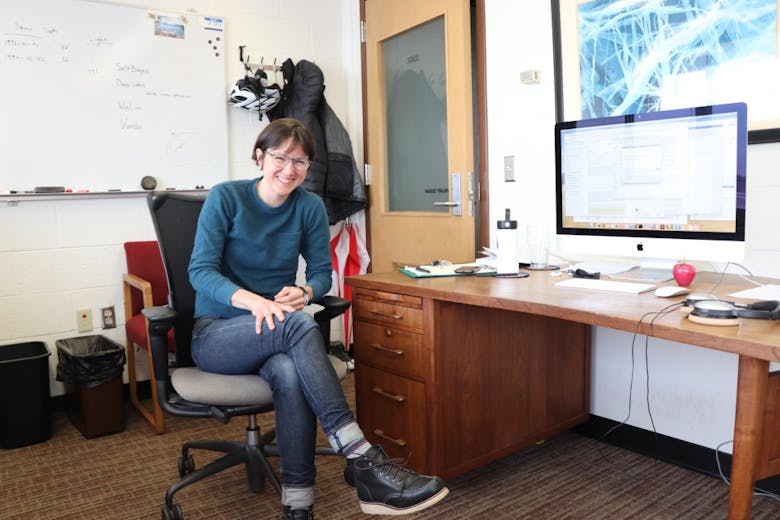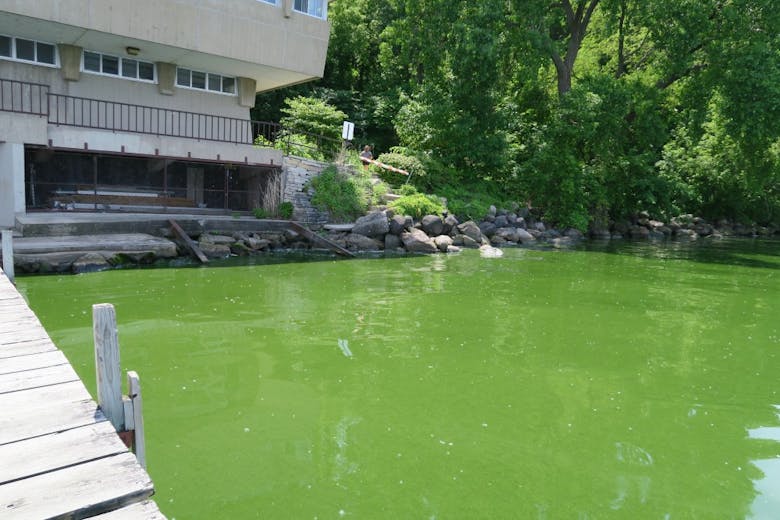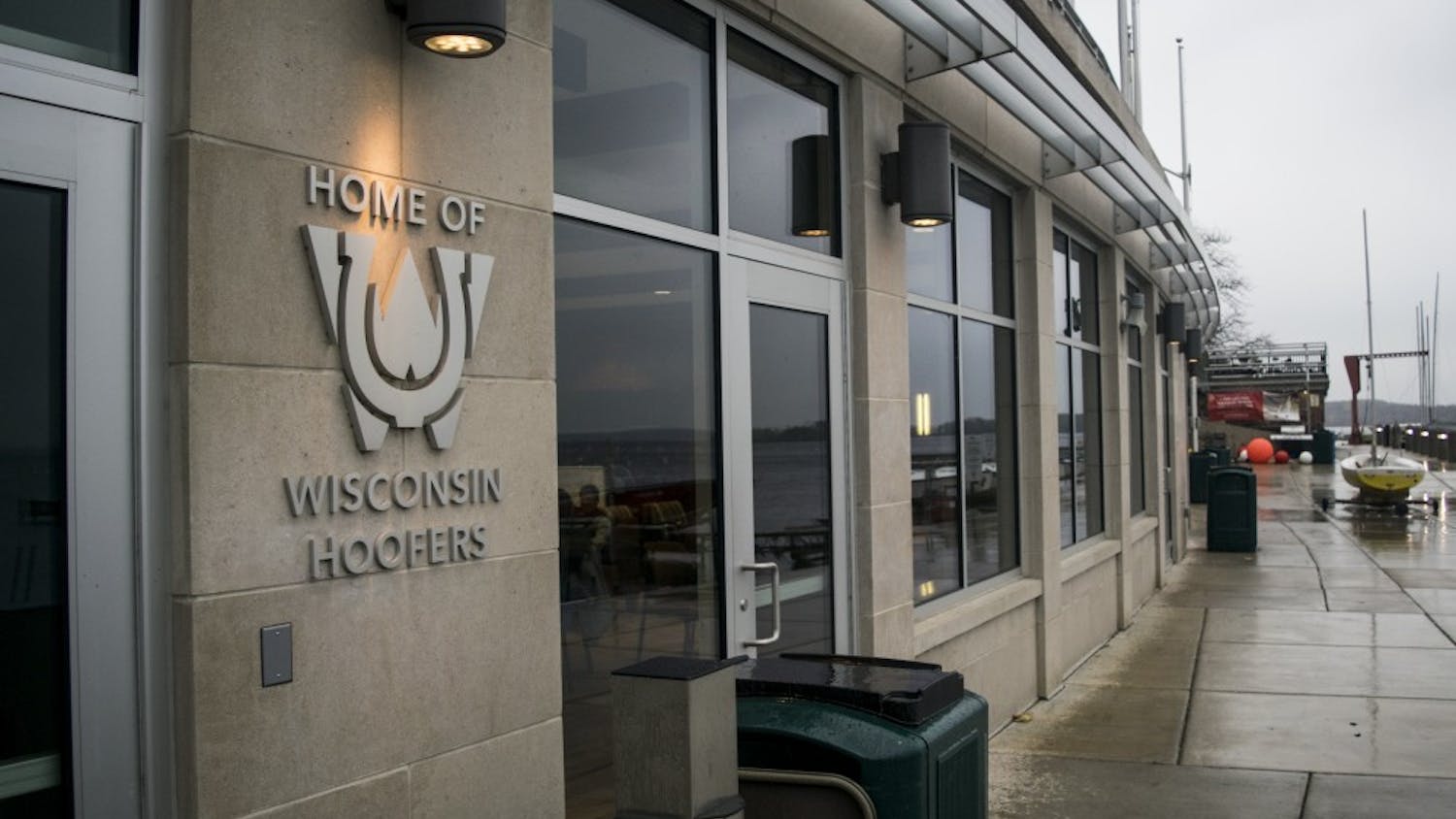When Rachel Illgen got off the water, the white shirt she wore to practice was stained green.
It was late May 2018, and the then-sophomore lightweight rower was training for the National Championships. She was just in time for the first of many algae blooms that would erupt across Lake Mendota over the course of the summer.
“What people may not realize is that rowing has a lot of water splashing and it just gets everywhere,” Illgen said. “When there's algae, I would say it’s pretty nasty.”
For Wisconsin's rowing program, navigating summer algae blooms has become part of the sport. But long-time coaches Bebe Bryans and Chris Clark can remember a time when they didn’t have to check campus water quality warnings before practice or change their courses to find remaining patches of open water.
“We don’t talk about it, but the lakes are a mess,” said Clark, head coach of the men’s rowing team. “All I know is what I’ve observed.”
Orange thermal suits hang on the walls of Clark’s office, the type you’d pack on an arctic expedition. From his desk, he can see the water sweeping out in all directions. In the more than 20 years he's spent as Wisconsin's rowing coach, he’s come to know the lake in a way few can.
When we talked, the water was still frozen — but Clark said just barely. He thinks he can tell when the ice will break up based on the way its color changes from grey to white and back to grey.
Clark and his team have spent the winter pounding out meters on the ergs, and they're anxious to launch their boats back on the lake. Despite spending fewer weeks on the water than their competition in warmer climates, both the men and women’s teams are seated in the top 15 nationally.
“We get so excited about better weather for rowing, we ignore the bad things that come with it, like algae and dirty water,” Clark said. “But we’re out here the whole time, and we see it all.”
Bryans has been head coach of the women’s team 16 years. When she started, she would swim from the boathouse docks to Picnic Point and back. She doesn’t do that anymore.
“We’re getting blooms earlier, even at the end of our season,” Bryans said. “It’s noticeable way earlier than it used to be, and it gets really bad way sooner.”
Harmful blue-green algae — which are actually colonies of a cyanobacteria called microcystis— have devastating impacts on lake ecosystems and produce toxins that can put humans at risk as well.
Not all algae is harmful, but during a bloom, it can be hard to tell if water is safe without testing it first. And a beach or two showing signs of toxic growth doesn’t automatically mean the whole lake is contaminated.
Regular monitoring and strong communication between rowers and health officials is key to keeping crews healthy.
Healthy crews are better crews
The human health effects of blue-green algae are generally categorized by mode of contact, according Jeffrey Steele, environmental health specialist with University Health Services. Part of his role entails monitoring water quality at Wisconsin Union swimming spots and keeping campus authorities informed of any health threats.
“When blue-green algae comes in contact with skin, it causes acute dermatitis, which is reddening or inflammation of the skin. It’s a really itchy irritation,” Steele said. “That’s the most common. It’s temporary though, and the best way to treat that is by washing with soap and water.”
Blue green algae can also cause more serious gastrointestinal issues, including diarrhea, abdominal pain and indigestion if swallowed. Exposure to larger amounts can lead to nervous system disorders and trigger seizures. Pets and small children are the most vulnerable to these symptoms.
Steele also pointed to ongoing research regarding algae’s pulmonary impacts. Preliminary findings from a Florida Gulf Coast University study have indicated toxins may become aerosolized in water droplets during heavy wave action or boating.
“More research and data collection is needed,” Steele said. “We’re just beginning to understand how it becomes aerosolized, what wind speed is necessary, or what wave action is needed for it to get inhaled. It’s ongoing research regarding what that is and what reaction we should have.”
Regardless, Steele noted that would be very difficult to keep people away from the lake in a city on an isthmus. It’s even harder to stay off the lake when you’re a rower.
“No one’s ever gotten sick from algae that I know of,” Clark said. “There’s not much you can do except avoid it. We try to get to the part of the lake that has the least algae. But you’ve just got to keep your mouth shut, basically.”
During the summer, Clark and Bryan actively follow lake quality warnings and do their best to stick to clear water. Sometimes though, encounters with algae are unavoidable.
There are days when the wind drifts the algae right around the Porter Boathouse docks. To access the clearer water only a few hundred meters offshore, rowers must still maneuver their boats through a gauntlet of algae.
“When the blue-green is bad, it’s all over the guys’ backs and faces,” Clark said. “We’re always getting splashed from rowing, people don’t realize that. But if it’s clean water, you don’t notice and you don’t care.”
As a coach, Bryans follows the risk closely and prioritizes her team’s safety over time on the water.
“As far as health and safety go, we’re the front line of defense and we take that very seriously,” Bryans said. “We follow the health department's guidelines on what we can and can’t do.”
On days when the algae is bad, Bryans will steer her rowers toward clearer parts of the lake. She’ll avoid sending crews out in smaller boats, which are less stable.
While both the athletic training department and University Health Services are aware that the algae is a problem, neither work directly with the rowing team to manage exposure risks.
“It’s not an issue they have to deal with much — if at all — because the blooms don’t overlap with when they’re out there,” said Paul Capobianco, assistant director of Athletic Communications. “The coaches are pretty in tune with everything going on on the lake all the time, so I would assume they are aware of when there are issues.”
Algae blooms peak on the lake during the mid-summer months. Like Capobianco mentioned, those months aren't part of the official crew season. Still, there are rowers on the water from June until August participating in development camps and making up for strokes they lost when the lakes were frozen.
Summer development camps are an important outreach opportunity for the team. They also are key in recruiting walk-on rowers. Bryans estimates they draw in 15-30 athletes every summer.
But toxic lakes make bad first impressions.
“It’s not awesome,” Bryans said. “We have to be careful, we can’t take them swimming, we have to make sure they shower right after practice. We won’t go out if it’s unsafe, but we’re not putting our best foot forward.”
Athletes say they are aware of the algae problem but less familiar with the risks it poses or symptoms exposure to toxic algae might cause.
“Overall, the general population of students may know that Mendota isn’t the cleanest lake. You can kind of tell that it’s not a clean body of water,” Illgen said. “We don’t really have discussions about how to prevent risk factors or anything.”

Hilary Dugan is a research scientist with UW-Madison's Center For Limnology. She said that managing nutrient run-off is one way to keep algae blooms at bay
Bloom and bust
The algae that blooms on Madison’s lakes is a product of the practices that take place on the land around them. And in Lake Mendota’s watershed, around 70 percent of that land is agricultural, according to Hillary Dugan, a researcher with UW-Madison’s Center for Limnology.
The fertilizers farmers use to grow their crops contain phosphorus, an element just as essential to sweet corn and rowers as it is to blue green algae. But when a big rain comes, the nutrient washes off surrounding fields and into the streams that feed the Yahara Lakes.
“In a normal lake in Wisconsin, the productivity of algae is limited by phosphorus — there’s just not enough of it to cause those blooms,” Dugan explained. “The blooms are happening here because we have too many nutrients in the lake. Mainly, it’s phosphorous.”
Add sunlight and a calm day and — wham! A swirling kaleidoscope of algae visible from space.
“Cyanobacteria love warm temperatures,” Dugan said. “The hotter it is, the happier they are. Plenty of light in the summer plus lots of nutrient runoff gets you a perfect storm of algae.”
Not all algae is harmful, according to Dugan. In fact, it can be a critical foundation for most aquatic food webs, and it plays a major role in regulating the way nutrients like carbon and phosphorous cycle through lake ecosystems.
But too much of anything can throw an ecosystem off-balance, and that is part of the reason the algae growing on the Yahara Lakes is a worry for researchers and rowers alike.
The real trouble starts when the algae dies, Dugan said.
As the mats of algae sink to the bottom of the lake, hungry microbes gobble them up. The decomposition process rapidly pulls oxygen out of the water, creating hostile conditions for fish and other freshwater species. The lack of oxygen can even spur chemical changes that unlock more phosphorous from the lake bed and exacerbate the cycle.
Invasive species like zebra mussels and spiny water flea have also been shown to promote algae growth, according to the Center for Limnology.
The timing and frequency of the blooms on Madison’s lakes is variable year to year and highly dependent on weather.
“Rain — especially big rainstorms — is so effective at transporting nutrients off the landscape,” Dugan said. “Years with lots of rain usually see lots of nutrients coming into the lake. Last year was probably one of the higher years because we had such a wet summer.”
In fact, 2018 saw a record number of beach closings, according to data from the Madison and Dane County Department of Public Health. Across the country, the Center for Disease Control reports that harmful algae blooms are occurring more frequently due to climate change.
“Not to be super pessimistic, but we’re not going to stop that climate change,” Dugan said. “So, we have a lot better chance of reigning in nutrient polluting. It’s going to be warmer, with more rain, and of those three, the one we might be able to win is the phosphorus input.”
Sliding Baselines
It’s not like management and pollution problems have gotten worse over time, though.
As recently as 40 years ago, the City of Madison pumped its raw sewage into the Yahara Lakes, Dugan pointed out. Water quality wasn’t great back then, either.
But even though subsequent regulations have limited the amount of phosphorous farmers can put on their fields and some of the most egregious dumping has come to a halt, the harmful blooms have not gone away.
“Things have gotten better, but also worse again,” Dugan said. “It’s hard to know what that trend is.”
While more than a century of high intensity land use in the Yahara watershed makes local patterns a little more complicated to interpret, Clark thinks lake conditions have worsened over the last 20 years he’s been coaching.
When the rowers finish practice on days the algae is especially bad, Clark said their boats are filthy.
“We have to rinse them all,” he said. “For the first 20 years I was here, we didn’t rinse boats. There was no point, they were clean. Now, we rinse every practice.”
But while these changes may be new to Clark and Bryans, for their freshman rowers they feel as familiar as tightening an oar lock before the start of a race.
“It’s not really anything that’s unexpected, it’s just something that happens,” Illgen said. “When it does happen, it’s gross, but it’s just that time of year.”
Clark is illustrating a phenomenon ecologists call a “shifting ecological baseline,” or the way people’s perceptions of “typical” environmental conditions evolve over time.
“It’s dangerous because you can just become complacent,” Dugan said. “It's so easy to be sitting on the Terrace during an algae bloom and just to think, ‘Oh well that just happens all the time.’”
Dugan also noted that exactly what that baseline is impacts the way people interpret changes from it.
“Our perception as relatively young people is way different than if you’ve lived through a lot of decades of certain conditions,” Dugan said. “What we consider a baseline for a lake is totally dependent on what you consider as a period of time for that baseline to be.”
It’s why the sense of orientation offered by long-term ecological data is so valuable for scientists, or anyone else striving to understand their place in a changing world.
Scientific understanding of algae blooms is also improving, meaning that perception of the risks they pose is changing as well.
“We’re a little bit more cautious about exposure,” Dugan said. “It’s probably pretty benign in general, but you would never want to put someone in a situation where they’re covered in toxic algae. Like I would never want to fall out of a rowing scull into that.”

On June 7, the summer’s first blue-green algae bloom turned much of Lake Mendota a thick, putrid green color. Regional climate models show that Madison will become warmer and wetter over the course of the century — conditions that may make blooms like this more frequent.
Setting a course for open water in a changing climate
Assuming future global carbon emissions follow current trends, regional climate models show summertime temperatures in south-central Wisconsin warming by an estimated 5.5°F by the end of the century, with periods of precipitation becoming more frequent, more intense and longer lasting.
“If we’re able to reduce phosphorus into the lake, there’s a good chance of curtailing more algae blooms in the future,” Dugan said. “If we do nothing, climate change is going to make things worse.”
Picking up yard and pet waste are a few of the things urban Madisonions can do to help keep phosphorous out of the lakes, according to an article The Center for Limnology published after the first of last year’s blooms.
More importantly, people can support the farmers working to be better land stewards, and the programs and policies that help them, the Center said.
For members of the rowing team and their coaches, progress feels especially personal. After all, they spend 15-20 hours per week on the water during the spring and fall, and they endure mentally-grueling indoor workouts all winger for the chance to get back outside.
Both teams are in the thick of their spring seasons, and will be travelling across the country nearly every weekend between now and the Big Ten championships, which they are hosting at Devil’s Lake.
The program is not going to let the blooms get in the way of their season, but Bryans said it will continually look for safer ways to train.
“It’s stressful, it’s distracting and it makes me mad,” she said. “We’re used to making anything work here, with the ice and the wind. It’s just one more thing, and it's something we can control. The ice and the wind are not.”






